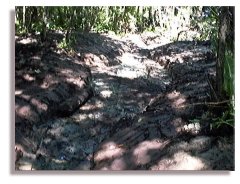Deep Pools, Wide Pools,
Long Pools
By Damien Barstead
If you were walking along the new Haig-Brown Kingfisher Creek channel currently under construction, it would be hard not to notice the number of pools that have been designed into the channel. They range in size from over a meter deep by ten or more meters wide, to smaller ones that are no bigger than one-meter square and a few inches deep. So why so many pools you ask?

A long shallow pool that will provide
coho with calm waters and shelter.
Every pool provides its own special type of fish habitat. Virtually all of the pools will have woody debris placed in them to provide cover, rearing space, and refuge for fish of all ages. However, other benefits will also be apparent.
|
Some other common uses for these pools, as identified by Biologists George Vardy and Caroline Heim, are: to provide sediment settling areas; to allow for water detention in times of low water levels; to provide resting holes for tired fish; and, to provide enough space for the fish to gather momentum when clearing obstacles, such as culvert outlets that they may need to navigate through.
Some other common uses for these pools, as identified by Biologists George Vardy and Caroline Heim, are: to provide sediment settling areas; to allow for water detention in times of low water levels; to provide resting holes for tired fish; and, to provide enough space for the fish to gather momentum when clearing obstacles, such as culvert outlets that they may need to navigate through.
By offering the salmon of Haig-Brown Kingfisher Creek the option of using these pools, it is hoped that they will increase their survival rate against such factors as predators or getting trapped on a dry streambed. In fact, it is hoped that the water stored in these pools may actually prevent the creek from drying out altogether during the normal summer season. It is hard to forecast how these water storage pools will actually affect the summer flows. However, the storage pools, in combination with added wetland waters flowing to the creek, may allow the coho to swim as far up or down the stream as they wish without ever getting stopped by mud or clay. This would be a positive feature because a freely swimming feeding fish is likely a healthy one.
Top of page.
|

